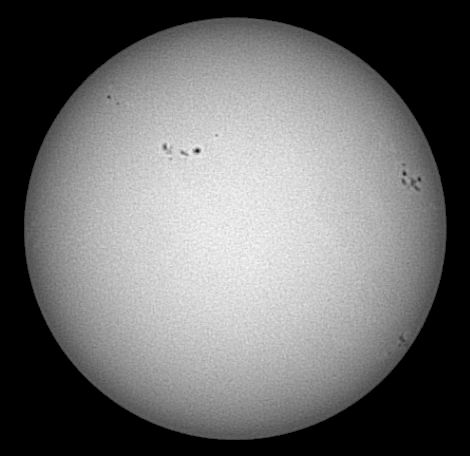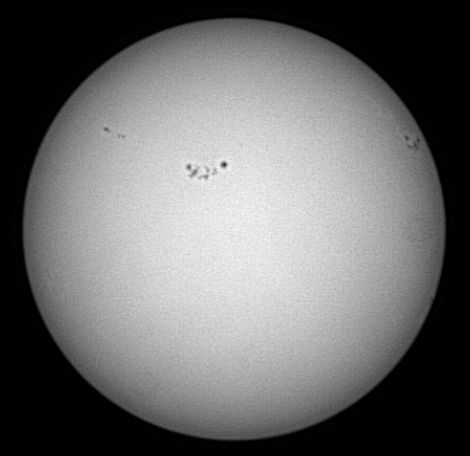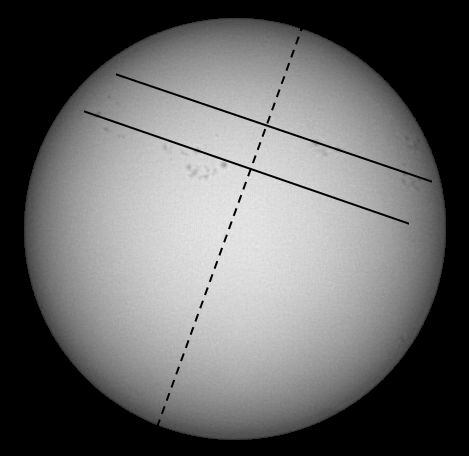

WARNING! The Sun is extremely dangerous. Looking at it
with any sort of optical aid will result in instant blindness.
Look here to
see how I do it.
The Sun has woken up again and there have been a number of significant spots since I last imaged the Sun. By March it had risen above my local horizon and these are my first images of 2011.
On this page I present three pictures of the whole Sun taken on 4th, 7th, and 8th of March 2011. Since the same spots appear on each picture I can use them here to find the axis of the Sun, which is not obvious on single pictures. It is always interesting to see how the appearance of sunspot groups changes from day to day, so I have grouped close-up pictures on their own pages: 11164, 11166, and 11167 and 11169.
It is a characteristic of sunspot cycles that, at the beginning of the cycle, small spots appear at middle latitudes and, as the cycle progresses, larger spots appear gradually nearer the equator as the cycle passes through its 11-year period, the last spots appearing near, but never on, the equator.
Move your mouse over the pictures below to see the number designations of the spots.
|
Sunspot Designations |
Sunspots and Active Regions are numbered by the American National Oceanic and Atmospheric Administration (NOAA) and started on 5th January 1972. These numbers now exceed 10000 but often the first or the first two digits are omitted. The designations of current sunspots can be found on the SOHO site. A most useful archive of diagrams of the Sun showing the positions and designations of sunspots on a daily basis right back to January 1992 is available from The Institute for Astronomy, University of Hawaii. This link will take you to their archive page from where you can select a given image by date or browse by month. I find this particularly useful if I have imaged an interesting spot after some days of cloud, and I can look back and see when the spot appeared. The Institute also has recent pictures of the Sun's activity in a number of formats. |

|
Here is my first full-Sun image of the year. The spots look as if they are at fairly high latitudes in the northern hemisphere, but this is not so. (Group 11167 is small and not visible in this image.) According to The University of Hawaii, group 11164 is at latitude 25° north, group 11166 is at about 9° north, and 11167 is at about 14° north.. Date and Time: 4 March 2011, 14:49 UT Camera: DMK 21AF04 Telescope: 270mm SLR lens Capture: ICCapture. 1/367", gain 285, 3600 frames Processing: Registax. 97 frames stacked. Wavelets 1-2 = 10, histogram 29-200 |

|
Here is the Sun taken 3 days later. You can see how the spots have moved as the Sun has rotated. I can use these two pictures to determine where the Sun's axis of rotation is (see below). Date and Time: 7 March 2011, 13:00 UT Camera: DFK 21AF04 Telescope: 270mm SLR lens Capture: ICCapture. 1/250", gain 424, 1799 frames Processing: Registax. 112 frames stacked. Wavelets 1-2 = 10, histogram 10-240 |

|
Here is the Sun taken the next day. Date and Time: 8 March 2011, 12:10 UT Camera: DMK 21AF04 Telescope: 270mm SLR lens Capture: ICCapture. 1/436", gain 480, 3600 frames Processing: Registax. 100 frames stacked. Wavelets 1-2 = 10, histogram 0-148 |

|
One problem with pictures of the Sun is that it is not obvious where the polar axis is. The axis is inclined at 7° to the ecliptic, but my camera is aligned with the Earth's axis which is inclined at 23½° to the ecliptic. However sunspots do not drift perceptively in the short time we can see them, so we can use the pictures above to determine where the Sun's axis is. I have tried to do that here. I have superimposed the three pictures above and drawn two lines through corresponding spots. (The alignments are not perfect because I didn't get my camera exactly aligned with the telescope each time.) You can see that the axis is not vertical and so the spots are at a lower latitude than I thought when I saw the first picture. These are not the first spots of this cycle; there have been a number of small spots in this cycle during the Sun's quiet phase; For example see here. Date and Time: 8 March 2011, 12:10 UT Camera: DMK 21AF04 Telescope: 270mm SLR lens Capture: ICCapture. 1/436", gain 480, 3600 frames Processing: Registax. 100 frames stacked. Wavelets 1-2 = 10, histogram 0-148 |
Close-up pictures of the spots can be found on their own pages: 11164, 11166, and 11167 and 11169.